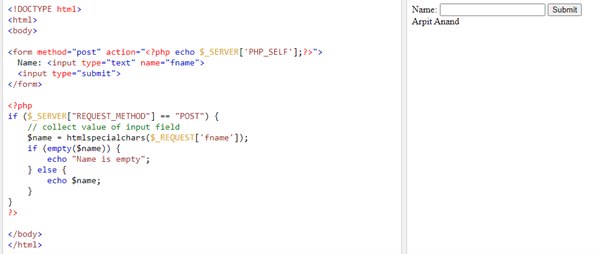
PHP comes out a function of $_Request that basically collects data submitted some data is generated, and $_Request is used to collect the data over. It by default contains the content of $GET , $POST , $COOKIE.
ADVERTISEMENT Popular Course in this category PHP DEVELOPER - Specialization | 8 Course Series | 3 Mock TestsStart Your Free Software Development Course
Web development, programming languages, Software testing & others
Whenever while creating an HTML Form, whenever a request is submitted, data is transferred, so $_Request is used to collect the data in PHP. It is a superglobal variable that is available in all the scopes throughout the PHP Script. It is available after PHP version 4 and above. In PHP version 7.0, we have the default settings from which the _REQUEST Array does not contain cookies. The .ini default file of PHP can also exclude the cookies from $_Request.
Syntax
The Syntax for getting details using the $ Request function is:-
Screenshot:-

The $_Request variable has the content of $GET, $POST, and $COOKIES, which collects the data from the HTML Form when submitted. It takes the input in HTML form, which makes it compulsory to have a form in HTML that has the method GET and method POST. After this, we can have the Request variable to collect the data needed.
$_REQUEST will use the requested method that is written to fetch the data; if $GET is written, it will use the GET method, and if $POST is written, it will use the post. Once this request is made and the variable is called, it collects the data needed or the data we want.
Let us see some functioning of $_Request with some Example:-
Let’s start by creating an HTML form and see how the Request Generates.
Method Used Post:-
HTML FORM:-
This is an HTML Form.
PHP POST Request Method:-
We are trying to create a FORM that takes Input as the Name, a request is submitted from the method POST with certain details, and the data is collected by the Request Method.
Here the htmlspecialchars($Request[‘fname’]) takes the value of the Input Field and checks whether any condition is given over there or not. If any condition is there that is checked or else the data is collected. So the Output for this will be something like:-
Name:

Screenshot:-

We are giving the Name as the Input as getting the data of the name as the output collected.
The same request can also be collected using the method GET; the only difference between GET and POST to be The get request can be Cached. And remains present in the browser History; also, the request can be bookmarked and can have length restrictions.
Lets us check that with a Simple Code Example:-
With Get Method: –
HTML FORM:-
PHP GET Request Method:-
We are trying to create a FORM that takes Input as the Name, a request is submitted from the method GET with certain details, and the data is collected by the Request Method.
It holds the same as what we saw for the POST example above.
In the case of $_Request, the data stored over these arrays are encoded data that is sent to the PHP Header. $Request makes it hard to control the information that is processed. Like, suppose if a user requests a Key-Value pair data like:-
REQUEST[‘key’] = value it will encode the data in the URL and save it to the array, and when we need the value, just call the REQUEST[‘key’] for a certain Value. It is a key from the super variable.
We can also use the $Request PHP function in the if-else loop and make the PHP code as per requirement.
Let us check that with a simple Example:-
Switch to NY'; echo 'Switch to US'; ?>
This is a sample code to check and change on the user request. With the request method, we collect and store the data as required, and then a loop is checked with checks whether the city needs to be changed. If yes, that request is executed; if no, there is no change. So by this method, we can also use the Request Function in PHP.
From the above article, we saw the use of Function $REQUEST in PHP. We tried to understand how the $REQUEST function works in PHP and what are used at the programming level from various examples and classifications.
We also saw the internal working and the advantages of having the type of data we define for various programming purposes. Also, the syntax and examples helped us to understand much precisely the function.
The above is the detailed content of PHP $_REQUEST. For more information, please follow other related articles on the PHP Chinese website!




